Strategic Analysis of Issues & Options for Port of Tauranga
VerifiedAdded on 2023/04/04
|10
|2370
|132
Report
AI Summary
This report provides a strategic analysis of the Port of Tauranga, focusing on key issues that have emerged over the past five years, including carrying capacity, changes in the economic portfolio, and rationalization of ownership. It explores strategic options for the port, emphasizing the importance of balancing commercial interests with socio-economic utility. The analysis utilizes the RACES framework (Resources, Acceptable, Coherent, Effective, Sustainable) to evaluate the port's current state and potential strategies. The report advocates for a strategy based on the principle of distributive justice to ensure sustainable growth and address both internal and external factors affecting the port's operations, considering the needs of the local economy, subsidized transportation, and major investors. The report concludes that a judicious implementation of this principle can effectively guide the port through its current challenges and secure the interests of all stakeholders. Desklib provides access to similar solved assignments and study resources for students.
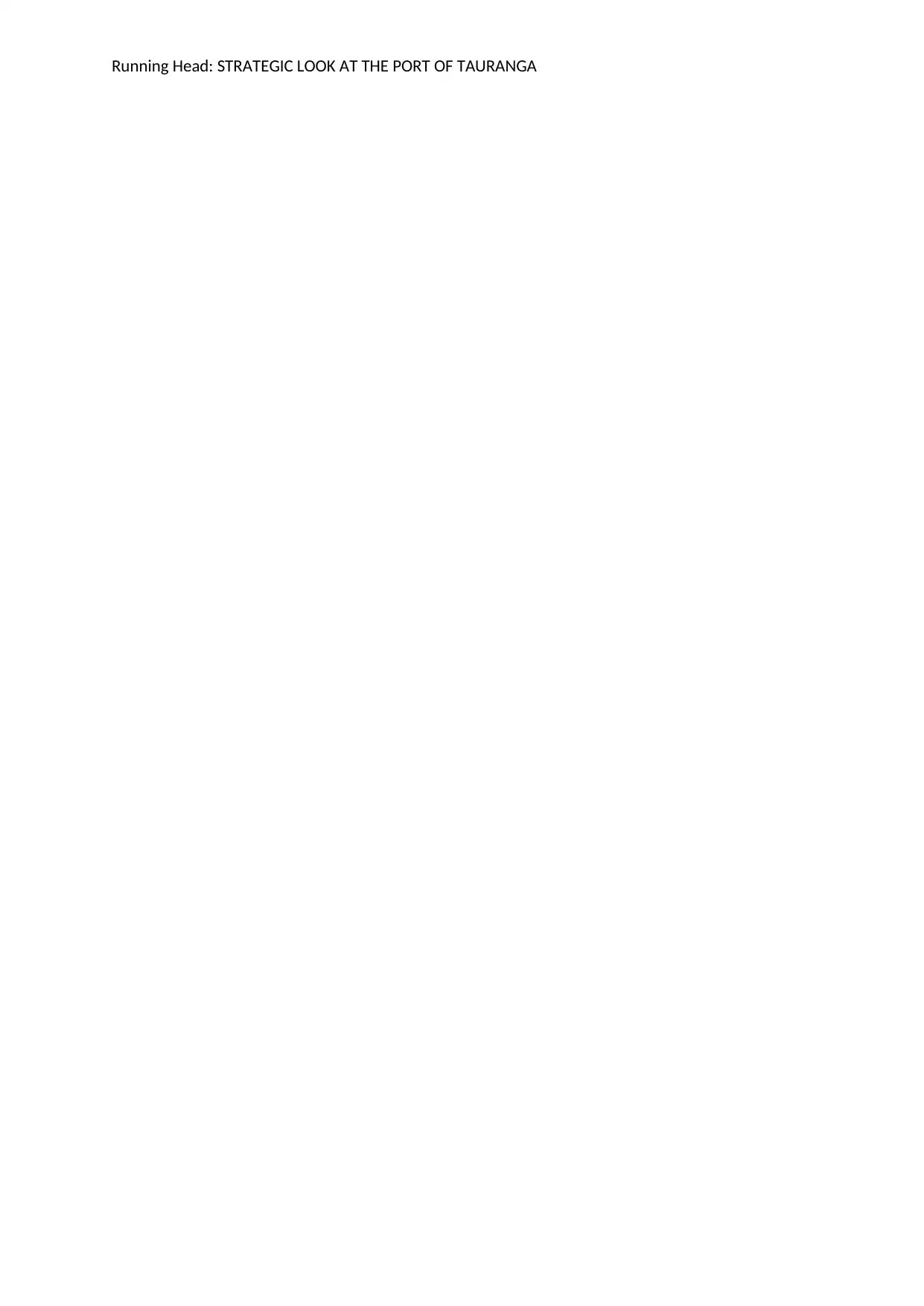
Running Head: STRATEGIC LOOK AT THE PORT OF TAURANGA
Paraphrase This Document
Need a fresh take? Get an instant paraphrase of this document with our AI Paraphraser
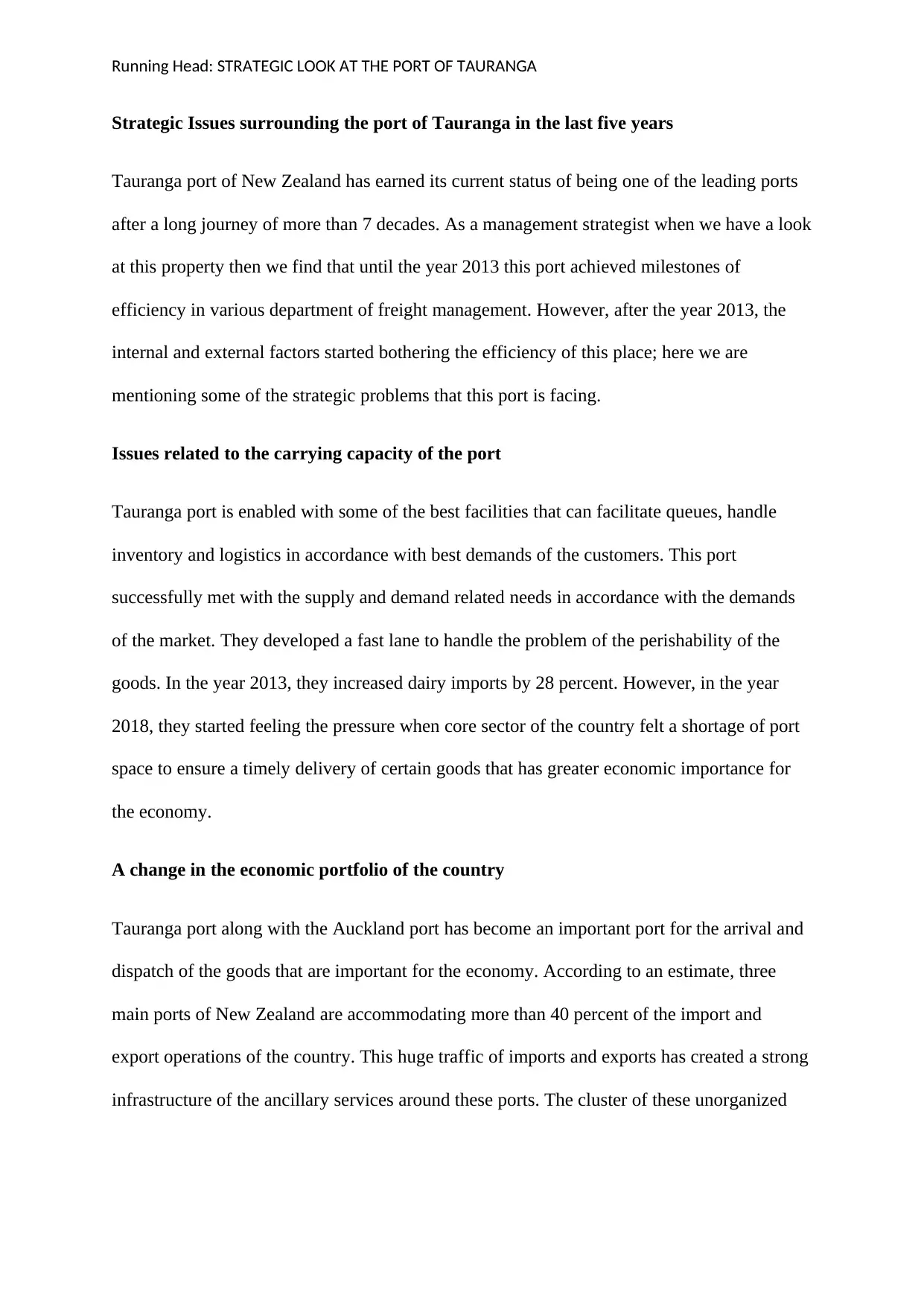
Running Head: STRATEGIC LOOK AT THE PORT OF TAURANGA
Strategic Issues surrounding the port of Tauranga in the last five years
Tauranga port of New Zealand has earned its current status of being one of the leading ports
after a long journey of more than 7 decades. As a management strategist when we have a look
at this property then we find that until the year 2013 this port achieved milestones of
efficiency in various department of freight management. However, after the year 2013, the
internal and external factors started bothering the efficiency of this place; here we are
mentioning some of the strategic problems that this port is facing.
Issues related to the carrying capacity of the port
Tauranga port is enabled with some of the best facilities that can facilitate queues, handle
inventory and logistics in accordance with best demands of the customers. This port
successfully met with the supply and demand related needs in accordance with the demands
of the market. They developed a fast lane to handle the problem of the perishability of the
goods. In the year 2013, they increased dairy imports by 28 percent. However, in the year
2018, they started feeling the pressure when core sector of the country felt a shortage of port
space to ensure a timely delivery of certain goods that has greater economic importance for
the economy.
A change in the economic portfolio of the country
Tauranga port along with the Auckland port has become an important port for the arrival and
dispatch of the goods that are important for the economy. According to an estimate, three
main ports of New Zealand are accommodating more than 40 percent of the import and
export operations of the country. This huge traffic of imports and exports has created a strong
infrastructure of the ancillary services around these ports. The cluster of these unorganized
Strategic Issues surrounding the port of Tauranga in the last five years
Tauranga port of New Zealand has earned its current status of being one of the leading ports
after a long journey of more than 7 decades. As a management strategist when we have a look
at this property then we find that until the year 2013 this port achieved milestones of
efficiency in various department of freight management. However, after the year 2013, the
internal and external factors started bothering the efficiency of this place; here we are
mentioning some of the strategic problems that this port is facing.
Issues related to the carrying capacity of the port
Tauranga port is enabled with some of the best facilities that can facilitate queues, handle
inventory and logistics in accordance with best demands of the customers. This port
successfully met with the supply and demand related needs in accordance with the demands
of the market. They developed a fast lane to handle the problem of the perishability of the
goods. In the year 2013, they increased dairy imports by 28 percent. However, in the year
2018, they started feeling the pressure when core sector of the country felt a shortage of port
space to ensure a timely delivery of certain goods that has greater economic importance for
the economy.
A change in the economic portfolio of the country
Tauranga port along with the Auckland port has become an important port for the arrival and
dispatch of the goods that are important for the economy. According to an estimate, three
main ports of New Zealand are accommodating more than 40 percent of the import and
export operations of the country. This huge traffic of imports and exports has created a strong
infrastructure of the ancillary services around these ports. The cluster of these unorganized
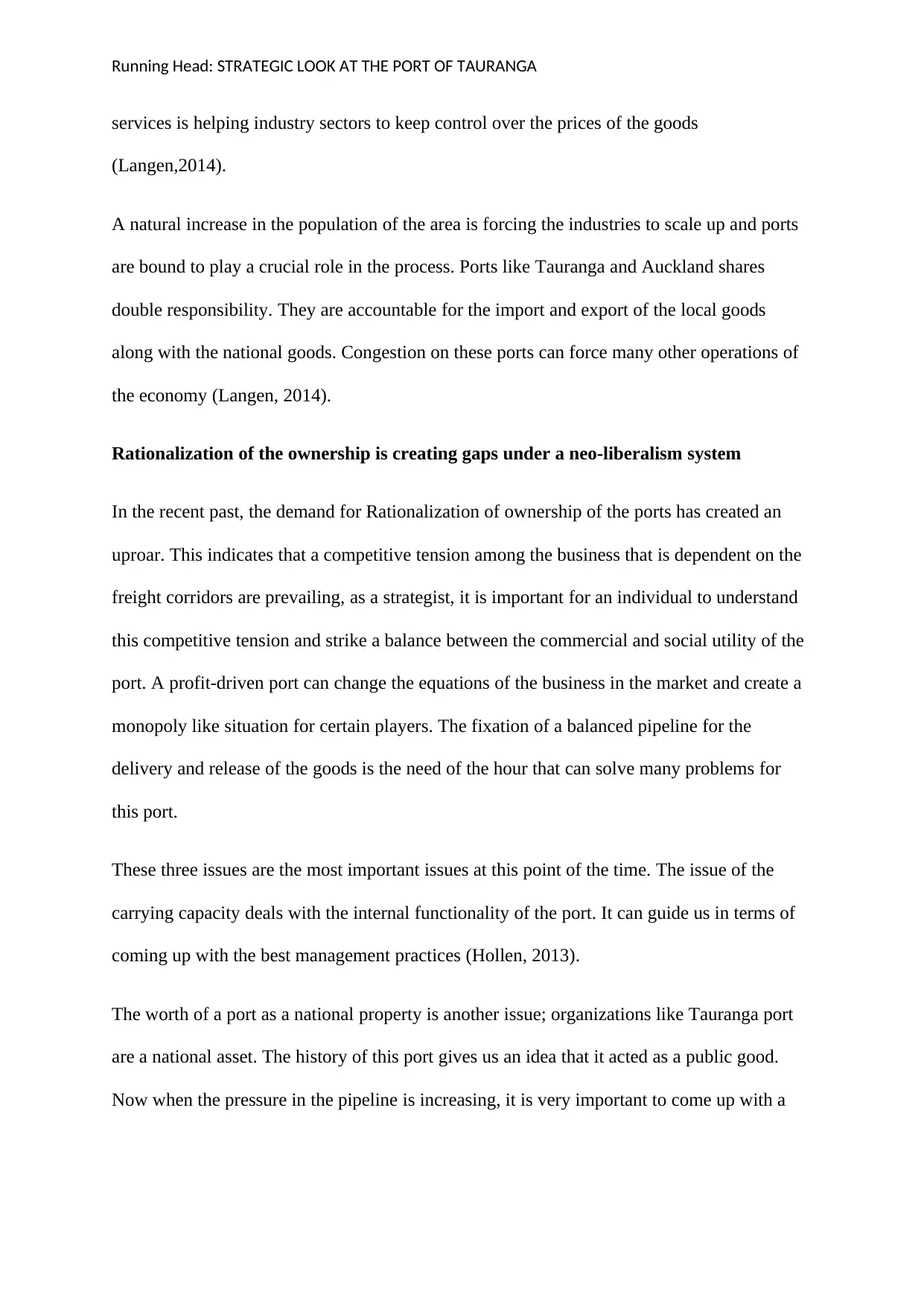
Running Head: STRATEGIC LOOK AT THE PORT OF TAURANGA
services is helping industry sectors to keep control over the prices of the goods
(Langen,2014).
A natural increase in the population of the area is forcing the industries to scale up and ports
are bound to play a crucial role in the process. Ports like Tauranga and Auckland shares
double responsibility. They are accountable for the import and export of the local goods
along with the national goods. Congestion on these ports can force many other operations of
the economy (Langen, 2014).
Rationalization of the ownership is creating gaps under a neo-liberalism system
In the recent past, the demand for Rationalization of ownership of the ports has created an
uproar. This indicates that a competitive tension among the business that is dependent on the
freight corridors are prevailing, as a strategist, it is important for an individual to understand
this competitive tension and strike a balance between the commercial and social utility of the
port. A profit-driven port can change the equations of the business in the market and create a
monopoly like situation for certain players. The fixation of a balanced pipeline for the
delivery and release of the goods is the need of the hour that can solve many problems for
this port.
These three issues are the most important issues at this point of the time. The issue of the
carrying capacity deals with the internal functionality of the port. It can guide us in terms of
coming up with the best management practices (Hollen, 2013).
The worth of a port as a national property is another issue; organizations like Tauranga port
are a national asset. The history of this port gives us an idea that it acted as a public good.
Now when the pressure in the pipeline is increasing, it is very important to come up with a
services is helping industry sectors to keep control over the prices of the goods
(Langen,2014).
A natural increase in the population of the area is forcing the industries to scale up and ports
are bound to play a crucial role in the process. Ports like Tauranga and Auckland shares
double responsibility. They are accountable for the import and export of the local goods
along with the national goods. Congestion on these ports can force many other operations of
the economy (Langen, 2014).
Rationalization of the ownership is creating gaps under a neo-liberalism system
In the recent past, the demand for Rationalization of ownership of the ports has created an
uproar. This indicates that a competitive tension among the business that is dependent on the
freight corridors are prevailing, as a strategist, it is important for an individual to understand
this competitive tension and strike a balance between the commercial and social utility of the
port. A profit-driven port can change the equations of the business in the market and create a
monopoly like situation for certain players. The fixation of a balanced pipeline for the
delivery and release of the goods is the need of the hour that can solve many problems for
this port.
These three issues are the most important issues at this point of the time. The issue of the
carrying capacity deals with the internal functionality of the port. It can guide us in terms of
coming up with the best management practices (Hollen, 2013).
The worth of a port as a national property is another issue; organizations like Tauranga port
are a national asset. The history of this port gives us an idea that it acted as a public good.
Now when the pressure in the pipeline is increasing, it is very important to come up with a
⊘ This is a preview!⊘
Do you want full access?
Subscribe today to unlock all pages.

Trusted by 1+ million students worldwide
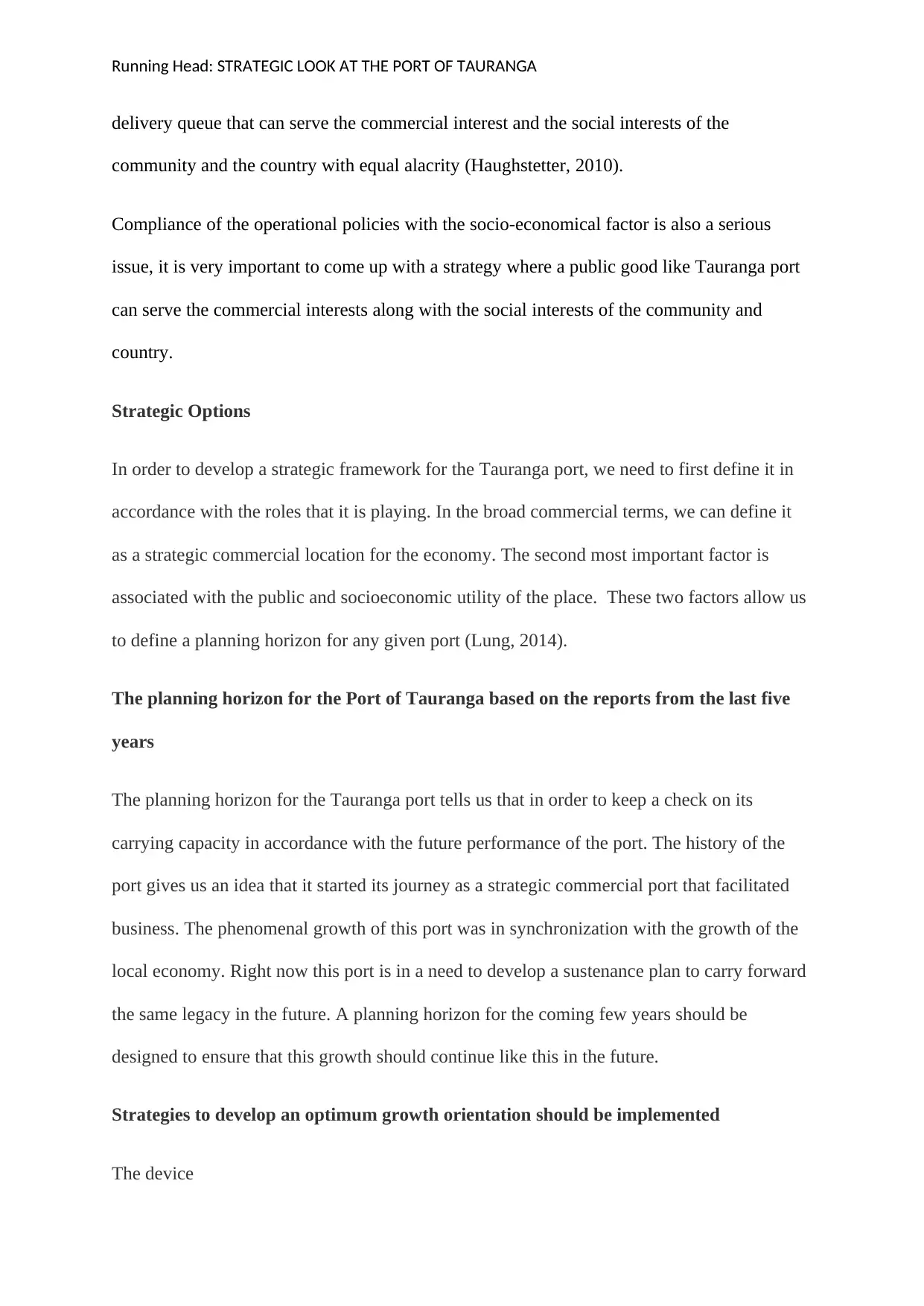
Running Head: STRATEGIC LOOK AT THE PORT OF TAURANGA
delivery queue that can serve the commercial interest and the social interests of the
community and the country with equal alacrity (Haughstetter, 2010).
Compliance of the operational policies with the socio-economical factor is also a serious
issue, it is very important to come up with a strategy where a public good like Tauranga port
can serve the commercial interests along with the social interests of the community and
country.
Strategic Options
In order to develop a strategic framework for the Tauranga port, we need to first define it in
accordance with the roles that it is playing. In the broad commercial terms, we can define it
as a strategic commercial location for the economy. The second most important factor is
associated with the public and socioeconomic utility of the place. These two factors allow us
to define a planning horizon for any given port (Lung, 2014).
The planning horizon for the Port of Tauranga based on the reports from the last five
years
The planning horizon for the Tauranga port tells us that in order to keep a check on its
carrying capacity in accordance with the future performance of the port. The history of the
port gives us an idea that it started its journey as a strategic commercial port that facilitated
business. The phenomenal growth of this port was in synchronization with the growth of the
local economy. Right now this port is in a need to develop a sustenance plan to carry forward
the same legacy in the future. A planning horizon for the coming few years should be
designed to ensure that this growth should continue like this in the future.
Strategies to develop an optimum growth orientation should be implemented
The device
delivery queue that can serve the commercial interest and the social interests of the
community and the country with equal alacrity (Haughstetter, 2010).
Compliance of the operational policies with the socio-economical factor is also a serious
issue, it is very important to come up with a strategy where a public good like Tauranga port
can serve the commercial interests along with the social interests of the community and
country.
Strategic Options
In order to develop a strategic framework for the Tauranga port, we need to first define it in
accordance with the roles that it is playing. In the broad commercial terms, we can define it
as a strategic commercial location for the economy. The second most important factor is
associated with the public and socioeconomic utility of the place. These two factors allow us
to define a planning horizon for any given port (Lung, 2014).
The planning horizon for the Port of Tauranga based on the reports from the last five
years
The planning horizon for the Tauranga port tells us that in order to keep a check on its
carrying capacity in accordance with the future performance of the port. The history of the
port gives us an idea that it started its journey as a strategic commercial port that facilitated
business. The phenomenal growth of this port was in synchronization with the growth of the
local economy. Right now this port is in a need to develop a sustenance plan to carry forward
the same legacy in the future. A planning horizon for the coming few years should be
designed to ensure that this growth should continue like this in the future.
Strategies to develop an optimum growth orientation should be implemented
The device
Paraphrase This Document
Need a fresh take? Get an instant paraphrase of this document with our AI Paraphraser
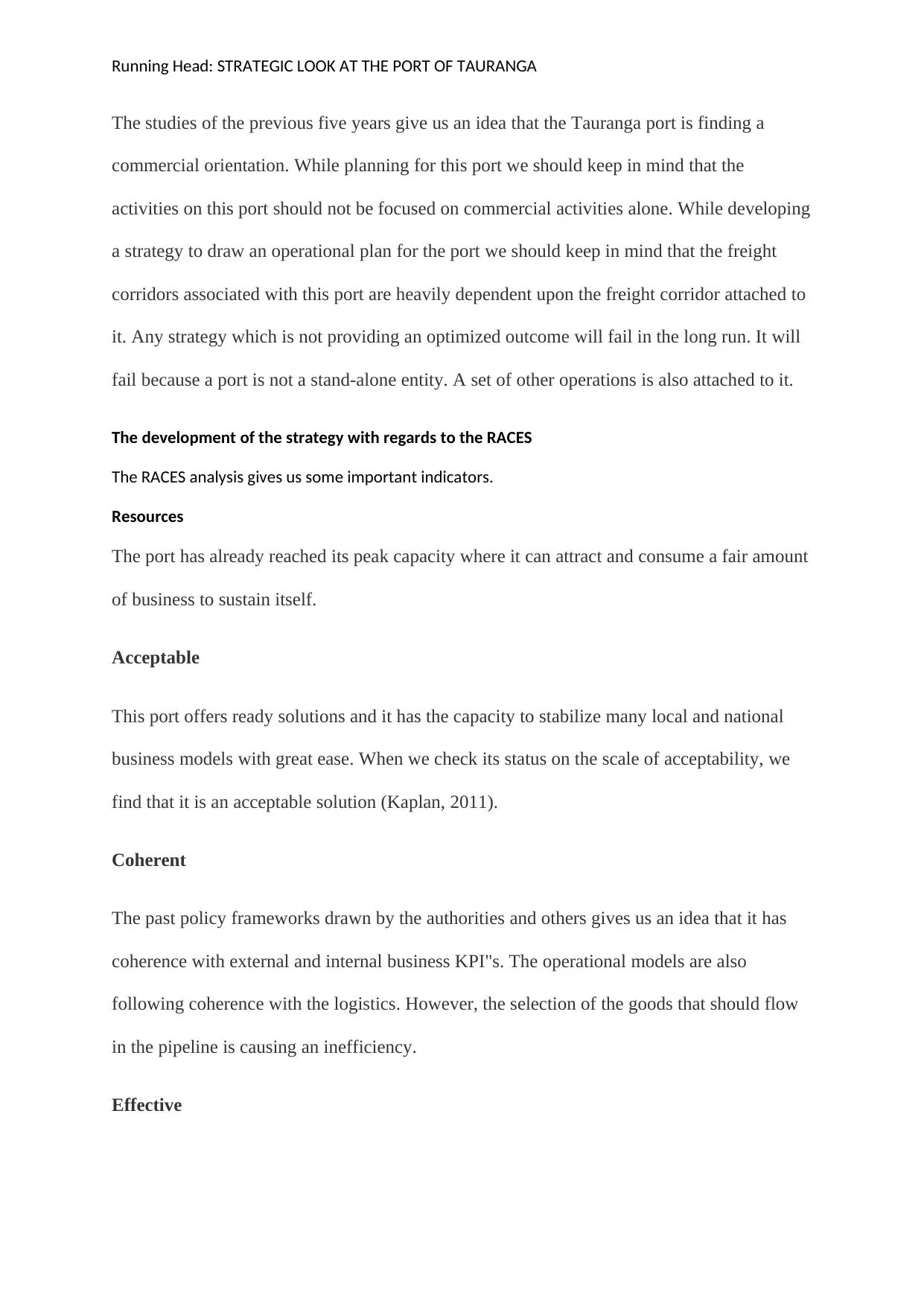
Running Head: STRATEGIC LOOK AT THE PORT OF TAURANGA
The studies of the previous five years give us an idea that the Tauranga port is finding a
commercial orientation. While planning for this port we should keep in mind that the
activities on this port should not be focused on commercial activities alone. While developing
a strategy to draw an operational plan for the port we should keep in mind that the freight
corridors associated with this port are heavily dependent upon the freight corridor attached to
it. Any strategy which is not providing an optimized outcome will fail in the long run. It will
fail because a port is not a stand-alone entity. A set of other operations is also attached to it.
The development of the strategy with regards to the RACES
The RACES analysis gives us some important indicators.
Resources
The port has already reached its peak capacity where it can attract and consume a fair amount
of business to sustain itself.
Acceptable
This port offers ready solutions and it has the capacity to stabilize many local and national
business models with great ease. When we check its status on the scale of acceptability, we
find that it is an acceptable solution (Kaplan, 2011).
Coherent
The past policy frameworks drawn by the authorities and others gives us an idea that it has
coherence with external and internal business KPI"s. The operational models are also
following coherence with the logistics. However, the selection of the goods that should flow
in the pipeline is causing an inefficiency.
Effective
The studies of the previous five years give us an idea that the Tauranga port is finding a
commercial orientation. While planning for this port we should keep in mind that the
activities on this port should not be focused on commercial activities alone. While developing
a strategy to draw an operational plan for the port we should keep in mind that the freight
corridors associated with this port are heavily dependent upon the freight corridor attached to
it. Any strategy which is not providing an optimized outcome will fail in the long run. It will
fail because a port is not a stand-alone entity. A set of other operations is also attached to it.
The development of the strategy with regards to the RACES
The RACES analysis gives us some important indicators.
Resources
The port has already reached its peak capacity where it can attract and consume a fair amount
of business to sustain itself.
Acceptable
This port offers ready solutions and it has the capacity to stabilize many local and national
business models with great ease. When we check its status on the scale of acceptability, we
find that it is an acceptable solution (Kaplan, 2011).
Coherent
The past policy frameworks drawn by the authorities and others gives us an idea that it has
coherence with external and internal business KPI"s. The operational models are also
following coherence with the logistics. However, the selection of the goods that should flow
in the pipeline is causing an inefficiency.
Effective
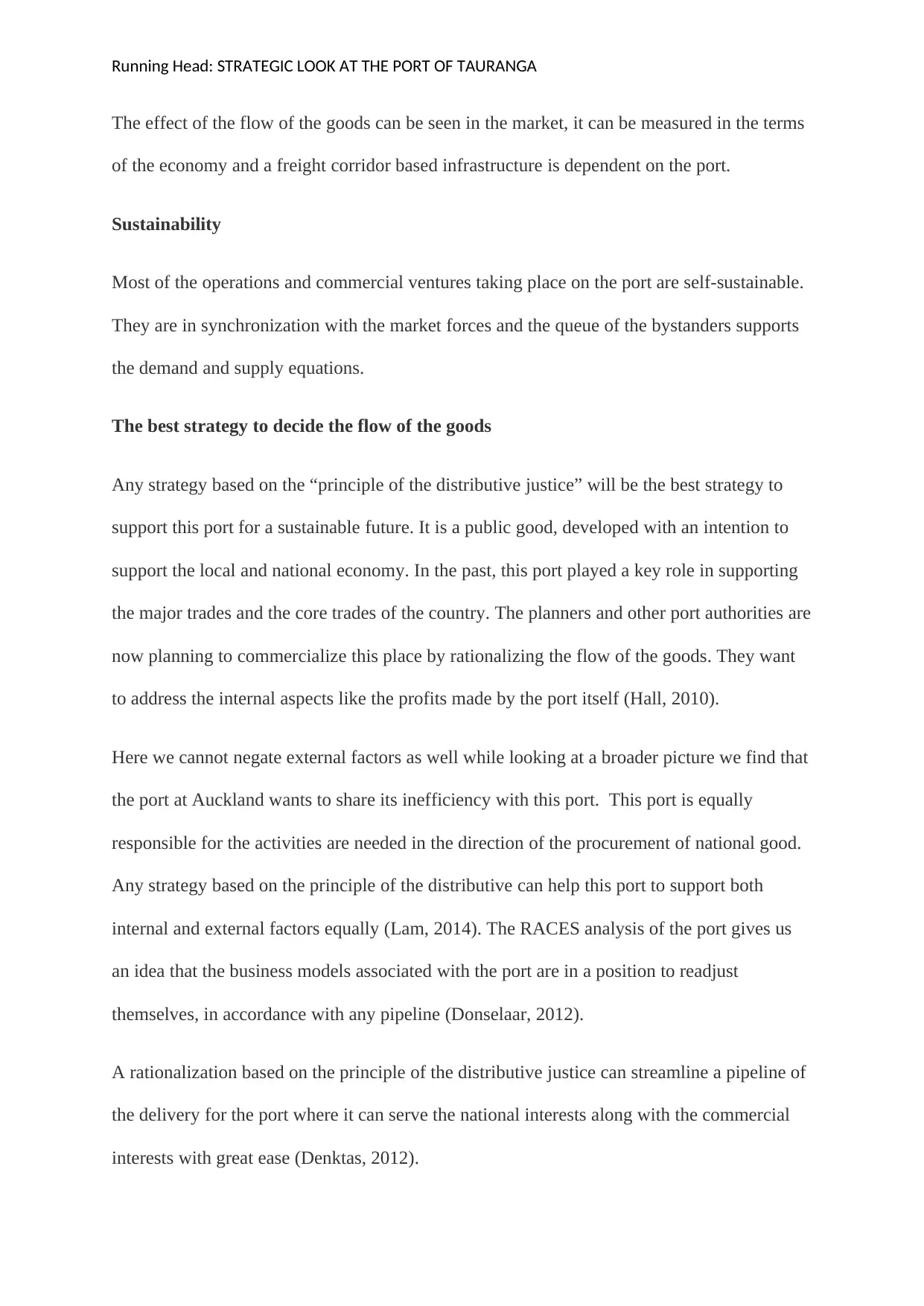
Running Head: STRATEGIC LOOK AT THE PORT OF TAURANGA
The effect of the flow of the goods can be seen in the market, it can be measured in the terms
of the economy and a freight corridor based infrastructure is dependent on the port.
Sustainability
Most of the operations and commercial ventures taking place on the port are self-sustainable.
They are in synchronization with the market forces and the queue of the bystanders supports
the demand and supply equations.
The best strategy to decide the flow of the goods
Any strategy based on the “principle of the distributive justice” will be the best strategy to
support this port for a sustainable future. It is a public good, developed with an intention to
support the local and national economy. In the past, this port played a key role in supporting
the major trades and the core trades of the country. The planners and other port authorities are
now planning to commercialize this place by rationalizing the flow of the goods. They want
to address the internal aspects like the profits made by the port itself (Hall, 2010).
Here we cannot negate external factors as well while looking at a broader picture we find that
the port at Auckland wants to share its inefficiency with this port. This port is equally
responsible for the activities are needed in the direction of the procurement of national good.
Any strategy based on the principle of the distributive can help this port to support both
internal and external factors equally (Lam, 2014). The RACES analysis of the port gives us
an idea that the business models associated with the port are in a position to readjust
themselves, in accordance with any pipeline (Donselaar, 2012).
A rationalization based on the principle of the distributive justice can streamline a pipeline of
the delivery for the port where it can serve the national interests along with the commercial
interests with great ease (Denktas, 2012).
The effect of the flow of the goods can be seen in the market, it can be measured in the terms
of the economy and a freight corridor based infrastructure is dependent on the port.
Sustainability
Most of the operations and commercial ventures taking place on the port are self-sustainable.
They are in synchronization with the market forces and the queue of the bystanders supports
the demand and supply equations.
The best strategy to decide the flow of the goods
Any strategy based on the “principle of the distributive justice” will be the best strategy to
support this port for a sustainable future. It is a public good, developed with an intention to
support the local and national economy. In the past, this port played a key role in supporting
the major trades and the core trades of the country. The planners and other port authorities are
now planning to commercialize this place by rationalizing the flow of the goods. They want
to address the internal aspects like the profits made by the port itself (Hall, 2010).
Here we cannot negate external factors as well while looking at a broader picture we find that
the port at Auckland wants to share its inefficiency with this port. This port is equally
responsible for the activities are needed in the direction of the procurement of national good.
Any strategy based on the principle of the distributive can help this port to support both
internal and external factors equally (Lam, 2014). The RACES analysis of the port gives us
an idea that the business models associated with the port are in a position to readjust
themselves, in accordance with any pipeline (Donselaar, 2012).
A rationalization based on the principle of the distributive justice can streamline a pipeline of
the delivery for the port where it can serve the national interests along with the commercial
interests with great ease (Denktas, 2012).
⊘ This is a preview!⊘
Do you want full access?
Subscribe today to unlock all pages.

Trusted by 1+ million students worldwide
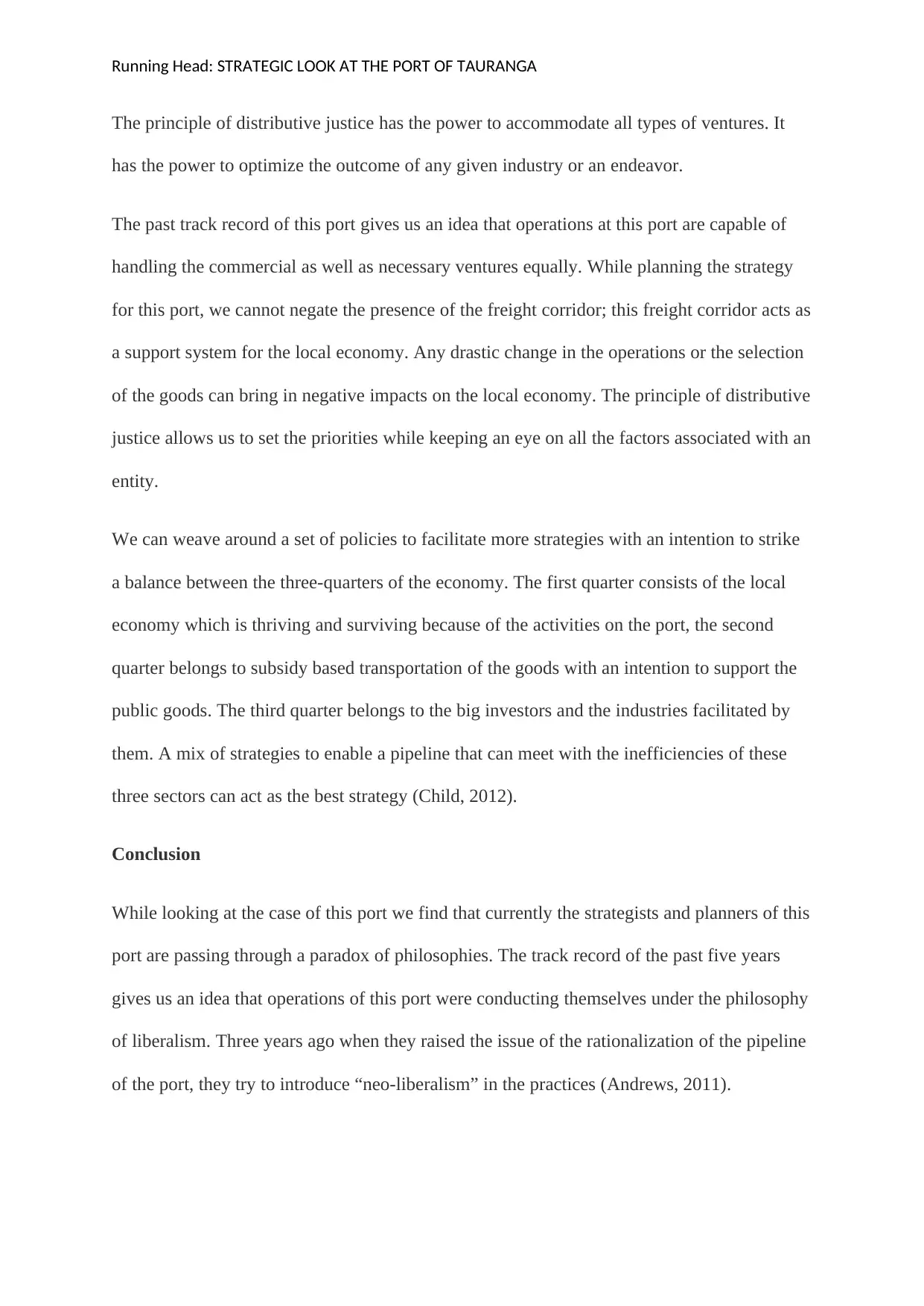
Running Head: STRATEGIC LOOK AT THE PORT OF TAURANGA
The principle of distributive justice has the power to accommodate all types of ventures. It
has the power to optimize the outcome of any given industry or an endeavor.
The past track record of this port gives us an idea that operations at this port are capable of
handling the commercial as well as necessary ventures equally. While planning the strategy
for this port, we cannot negate the presence of the freight corridor; this freight corridor acts as
a support system for the local economy. Any drastic change in the operations or the selection
of the goods can bring in negative impacts on the local economy. The principle of distributive
justice allows us to set the priorities while keeping an eye on all the factors associated with an
entity.
We can weave around a set of policies to facilitate more strategies with an intention to strike
a balance between the three-quarters of the economy. The first quarter consists of the local
economy which is thriving and surviving because of the activities on the port, the second
quarter belongs to subsidy based transportation of the goods with an intention to support the
public goods. The third quarter belongs to the big investors and the industries facilitated by
them. A mix of strategies to enable a pipeline that can meet with the inefficiencies of these
three sectors can act as the best strategy (Child, 2012).
Conclusion
While looking at the case of this port we find that currently the strategists and planners of this
port are passing through a paradox of philosophies. The track record of the past five years
gives us an idea that operations of this port were conducting themselves under the philosophy
of liberalism. Three years ago when they raised the issue of the rationalization of the pipeline
of the port, they try to introduce “neo-liberalism” in the practices (Andrews, 2011).
The principle of distributive justice has the power to accommodate all types of ventures. It
has the power to optimize the outcome of any given industry or an endeavor.
The past track record of this port gives us an idea that operations at this port are capable of
handling the commercial as well as necessary ventures equally. While planning the strategy
for this port, we cannot negate the presence of the freight corridor; this freight corridor acts as
a support system for the local economy. Any drastic change in the operations or the selection
of the goods can bring in negative impacts on the local economy. The principle of distributive
justice allows us to set the priorities while keeping an eye on all the factors associated with an
entity.
We can weave around a set of policies to facilitate more strategies with an intention to strike
a balance between the three-quarters of the economy. The first quarter consists of the local
economy which is thriving and surviving because of the activities on the port, the second
quarter belongs to subsidy based transportation of the goods with an intention to support the
public goods. The third quarter belongs to the big investors and the industries facilitated by
them. A mix of strategies to enable a pipeline that can meet with the inefficiencies of these
three sectors can act as the best strategy (Child, 2012).
Conclusion
While looking at the case of this port we find that currently the strategists and planners of this
port are passing through a paradox of philosophies. The track record of the past five years
gives us an idea that operations of this port were conducting themselves under the philosophy
of liberalism. Three years ago when they raised the issue of the rationalization of the pipeline
of the port, they try to introduce “neo-liberalism” in the practices (Andrews, 2011).
Paraphrase This Document
Need a fresh take? Get an instant paraphrase of this document with our AI Paraphraser
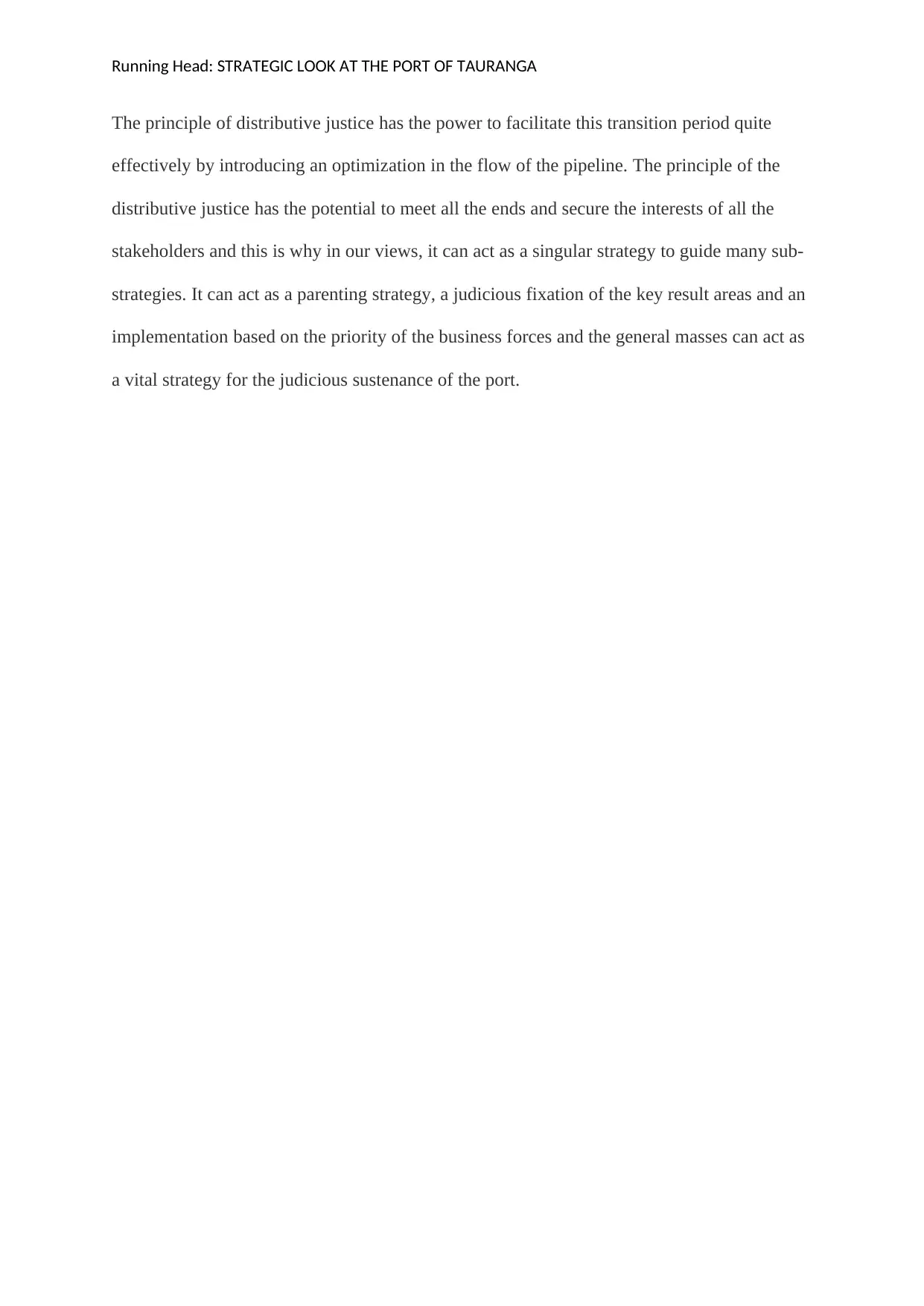
Running Head: STRATEGIC LOOK AT THE PORT OF TAURANGA
The principle of distributive justice has the power to facilitate this transition period quite
effectively by introducing an optimization in the flow of the pipeline. The principle of the
distributive justice has the potential to meet all the ends and secure the interests of all the
stakeholders and this is why in our views, it can act as a singular strategy to guide many sub-
strategies. It can act as a parenting strategy, a judicious fixation of the key result areas and an
implementation based on the priority of the business forces and the general masses can act as
a vital strategy for the judicious sustenance of the port.
The principle of distributive justice has the power to facilitate this transition period quite
effectively by introducing an optimization in the flow of the pipeline. The principle of the
distributive justice has the potential to meet all the ends and secure the interests of all the
stakeholders and this is why in our views, it can act as a singular strategy to guide many sub-
strategies. It can act as a parenting strategy, a judicious fixation of the key result areas and an
implementation based on the priority of the business forces and the general masses can act as
a vital strategy for the judicious sustenance of the port.
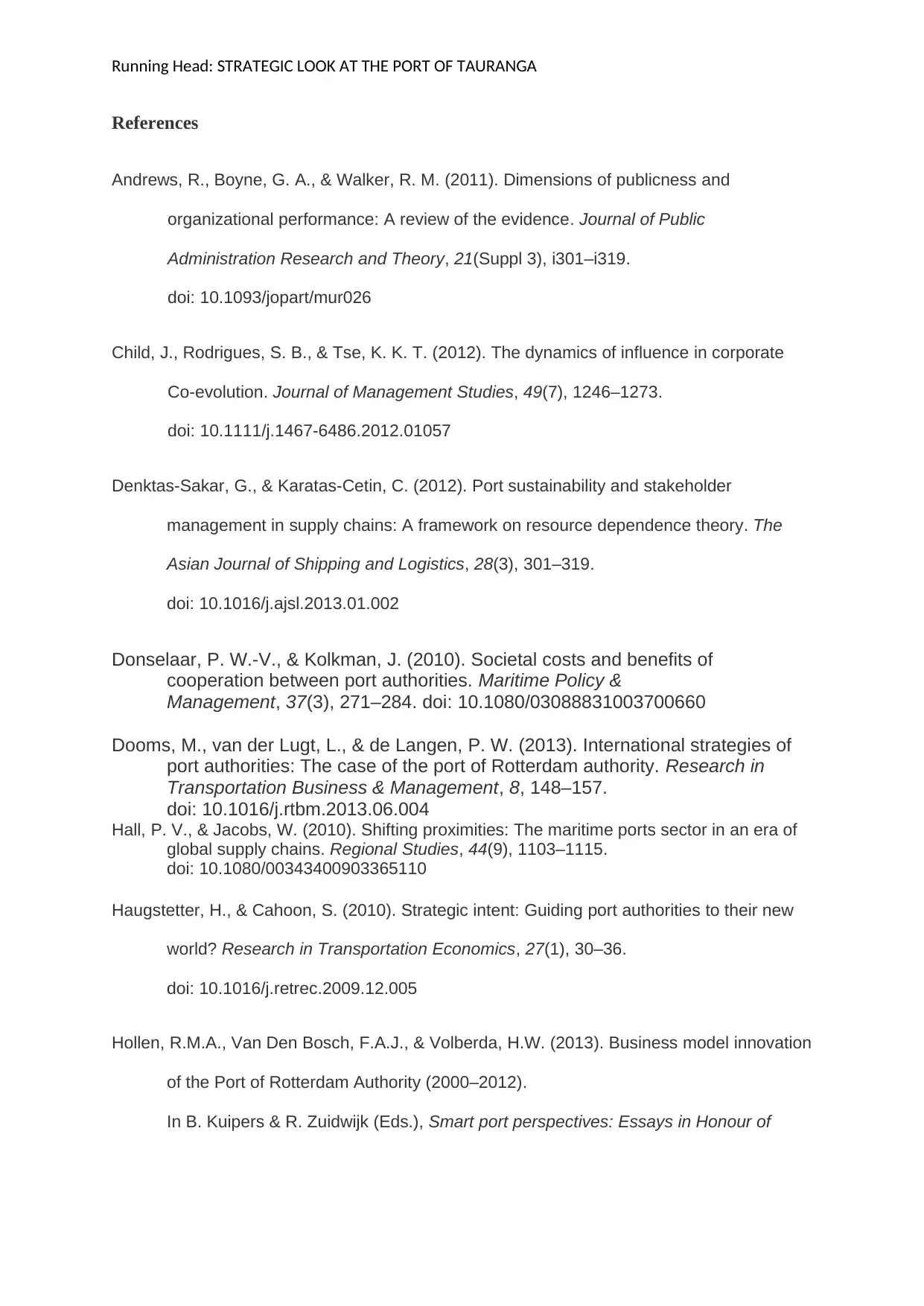
Running Head: STRATEGIC LOOK AT THE PORT OF TAURANGA
References
Andrews, R., Boyne, G. A., & Walker, R. M. (2011). Dimensions of publicness and
organizational performance: A review of the evidence. Journal of Public
Administration Research and Theory, 21(Suppl 3), i301–i319.
doi: 10.1093/jopart/mur026
Child, J., Rodrigues, S. B., & Tse, K. K. T. (2012). The dynamics of influence in corporate
Co-evolution. Journal of Management Studies, 49(7), 1246–1273.
doi: 10.1111/j.1467-6486.2012.01057
Denktas-Sakar, G., & Karatas-Cetin, C. (2012). Port sustainability and stakeholder
management in supply chains: A framework on resource dependence theory. The
Asian Journal of Shipping and Logistics, 28(3), 301–319.
doi: 10.1016/j.ajsl.2013.01.002
Donselaar, P. W.-V., & Kolkman, J. (2010). Societal costs and benefits of
cooperation between port authorities. Maritime Policy &
Management, 37(3), 271–284. doi: 10.1080/03088831003700660
Dooms, M., van der Lugt, L., & de Langen, P. W. (2013). International strategies of
port authorities: The case of the port of Rotterdam authority. Research in
Transportation Business & Management, 8, 148–157.
doi: 10.1016/j.rtbm.2013.06.004
Hall, P. V., & Jacobs, W. (2010). Shifting proximities: The maritime ports sector in an era of
global supply chains. Regional Studies, 44(9), 1103–1115.
doi: 10.1080/00343400903365110
Haugstetter, H., & Cahoon, S. (2010). Strategic intent: Guiding port authorities to their new
world? Research in Transportation Economics, 27(1), 30–36.
doi: 10.1016/j.retrec.2009.12.005
Hollen, R.M.A., Van Den Bosch, F.A.J., & Volberda, H.W. (2013). Business model innovation
of the Port of Rotterdam Authority (2000–2012).
In B. Kuipers & R. Zuidwijk (Eds.), Smart port perspectives: Essays in Honour of
References
Andrews, R., Boyne, G. A., & Walker, R. M. (2011). Dimensions of publicness and
organizational performance: A review of the evidence. Journal of Public
Administration Research and Theory, 21(Suppl 3), i301–i319.
doi: 10.1093/jopart/mur026
Child, J., Rodrigues, S. B., & Tse, K. K. T. (2012). The dynamics of influence in corporate
Co-evolution. Journal of Management Studies, 49(7), 1246–1273.
doi: 10.1111/j.1467-6486.2012.01057
Denktas-Sakar, G., & Karatas-Cetin, C. (2012). Port sustainability and stakeholder
management in supply chains: A framework on resource dependence theory. The
Asian Journal of Shipping and Logistics, 28(3), 301–319.
doi: 10.1016/j.ajsl.2013.01.002
Donselaar, P. W.-V., & Kolkman, J. (2010). Societal costs and benefits of
cooperation between port authorities. Maritime Policy &
Management, 37(3), 271–284. doi: 10.1080/03088831003700660
Dooms, M., van der Lugt, L., & de Langen, P. W. (2013). International strategies of
port authorities: The case of the port of Rotterdam authority. Research in
Transportation Business & Management, 8, 148–157.
doi: 10.1016/j.rtbm.2013.06.004
Hall, P. V., & Jacobs, W. (2010). Shifting proximities: The maritime ports sector in an era of
global supply chains. Regional Studies, 44(9), 1103–1115.
doi: 10.1080/00343400903365110
Haugstetter, H., & Cahoon, S. (2010). Strategic intent: Guiding port authorities to their new
world? Research in Transportation Economics, 27(1), 30–36.
doi: 10.1016/j.retrec.2009.12.005
Hollen, R.M.A., Van Den Bosch, F.A.J., & Volberda, H.W. (2013). Business model innovation
of the Port of Rotterdam Authority (2000–2012).
In B. Kuipers & R. Zuidwijk (Eds.), Smart port perspectives: Essays in Honour of
⊘ This is a preview!⊘
Do you want full access?
Subscribe today to unlock all pages.

Trusted by 1+ million students worldwide
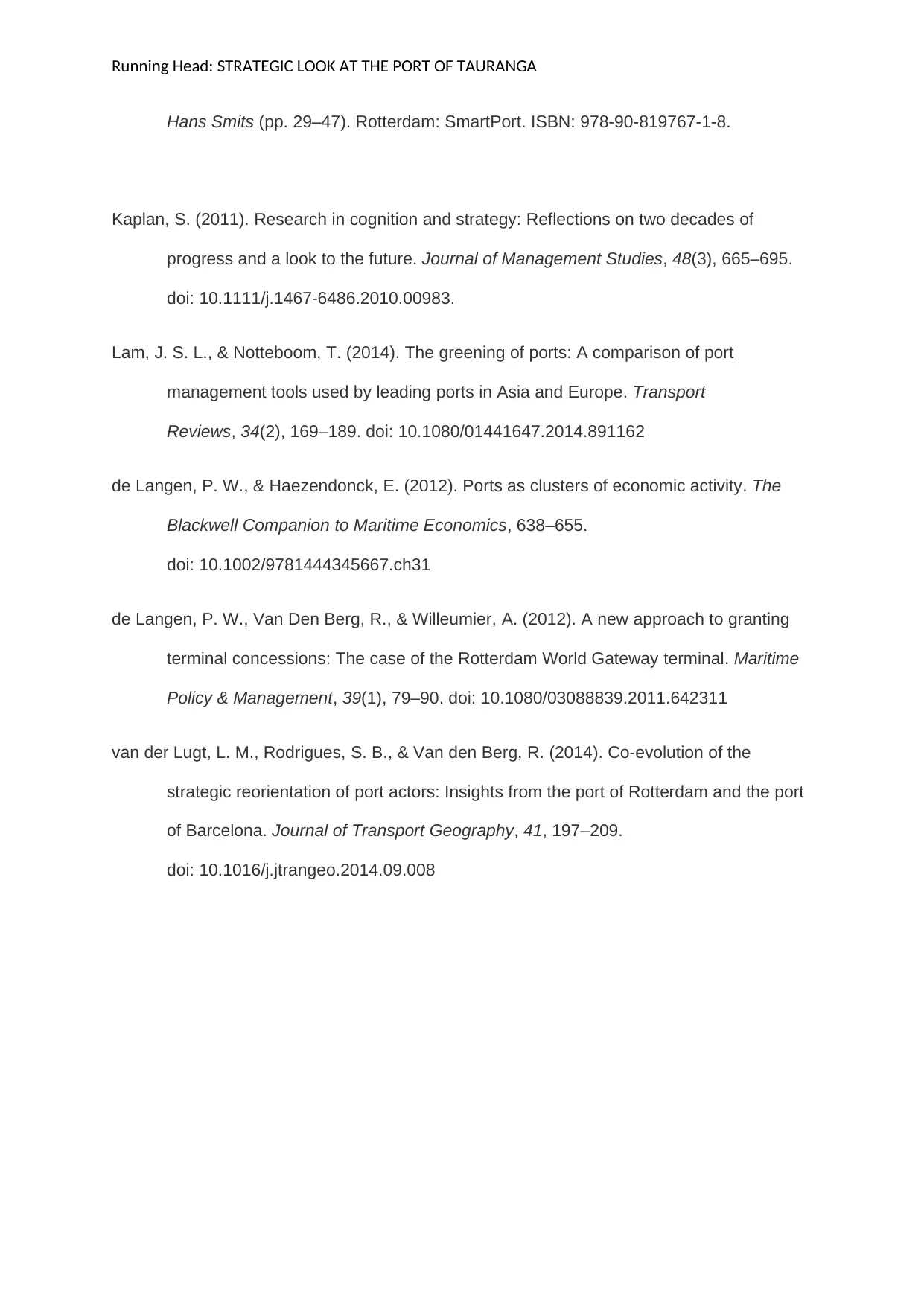
Running Head: STRATEGIC LOOK AT THE PORT OF TAURANGA
Hans Smits (pp. 29–47). Rotterdam: SmartPort. ISBN: 978-90-819767-1-8.
Kaplan, S. (2011). Research in cognition and strategy: Reflections on two decades of
progress and a look to the future. Journal of Management Studies, 48(3), 665–695.
doi: 10.1111/j.1467-6486.2010.00983.
Lam, J. S. L., & Notteboom, T. (2014). The greening of ports: A comparison of port
management tools used by leading ports in Asia and Europe. Transport
Reviews, 34(2), 169–189. doi: 10.1080/01441647.2014.891162
de Langen, P. W., & Haezendonck, E. (2012). Ports as clusters of economic activity. The
Blackwell Companion to Maritime Economics, 638–655.
doi: 10.1002/9781444345667.ch31
de Langen, P. W., Van Den Berg, R., & Willeumier, A. (2012). A new approach to granting
terminal concessions: The case of the Rotterdam World Gateway terminal. Maritime
Policy & Management, 39(1), 79–90. doi: 10.1080/03088839.2011.642311
van der Lugt, L. M., Rodrigues, S. B., & Van den Berg, R. (2014). Co-evolution of the
strategic reorientation of port actors: Insights from the port of Rotterdam and the port
of Barcelona. Journal of Transport Geography, 41, 197–209.
doi: 10.1016/j.jtrangeo.2014.09.008
Hans Smits (pp. 29–47). Rotterdam: SmartPort. ISBN: 978-90-819767-1-8.
Kaplan, S. (2011). Research in cognition and strategy: Reflections on two decades of
progress and a look to the future. Journal of Management Studies, 48(3), 665–695.
doi: 10.1111/j.1467-6486.2010.00983.
Lam, J. S. L., & Notteboom, T. (2014). The greening of ports: A comparison of port
management tools used by leading ports in Asia and Europe. Transport
Reviews, 34(2), 169–189. doi: 10.1080/01441647.2014.891162
de Langen, P. W., & Haezendonck, E. (2012). Ports as clusters of economic activity. The
Blackwell Companion to Maritime Economics, 638–655.
doi: 10.1002/9781444345667.ch31
de Langen, P. W., Van Den Berg, R., & Willeumier, A. (2012). A new approach to granting
terminal concessions: The case of the Rotterdam World Gateway terminal. Maritime
Policy & Management, 39(1), 79–90. doi: 10.1080/03088839.2011.642311
van der Lugt, L. M., Rodrigues, S. B., & Van den Berg, R. (2014). Co-evolution of the
strategic reorientation of port actors: Insights from the port of Rotterdam and the port
of Barcelona. Journal of Transport Geography, 41, 197–209.
doi: 10.1016/j.jtrangeo.2014.09.008
1 out of 10
Your All-in-One AI-Powered Toolkit for Academic Success.
+13062052269
info@desklib.com
Available 24*7 on WhatsApp / Email
![[object Object]](/_next/static/media/star-bottom.7253800d.svg)
Unlock your academic potential
Copyright © 2020–2025 A2Z Services. All Rights Reserved. Developed and managed by ZUCOL.
